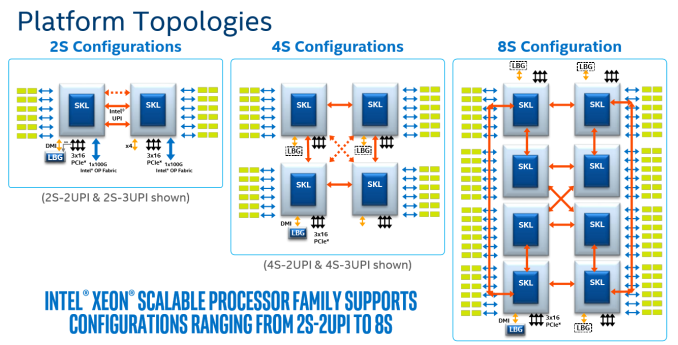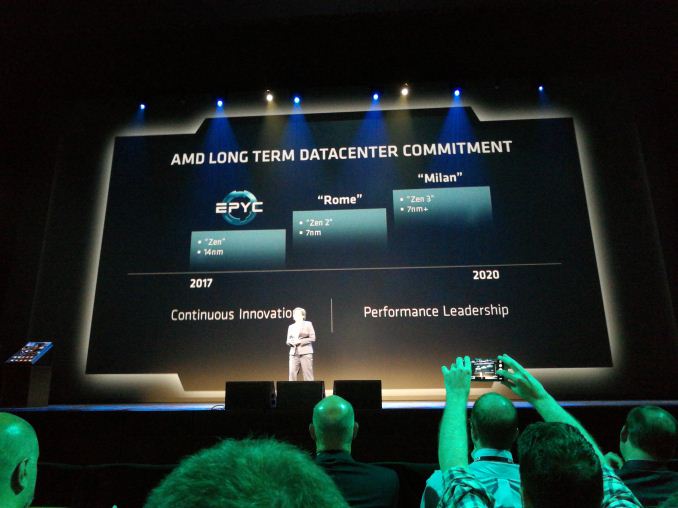Sizing Up Servers: Intel's Skylake-SP Xeon versus AMD's EPYC 7000 - The Server CPU Battle of the Decade?
by Johan De Gelas & Ian Cutress on July 11, 2017 12:15 PM EST- Posted in
- CPUs
- AMD
- Intel
- Xeon
- Enterprise
- Skylake
- Zen
- Naples
- Skylake-SP
- EPYC
Closing Thoughts
First of all, we have to emphasize that we were only able to spend about a week on the AMD server, and about two weeks on the Intel system. With the complexity of both server hardware and especially server software, that is very little time. There is still a lot to test and tune, but the general picture is clear.
We can continue to talk about Intel's excellent mesh topology and AMD strong new Zen architecture, but at the end of the day, the "how" will not matter to infrastructure professionals. Depending on your situation, performance, performance-per-watt, and/or performance-per-dollar are what matters.
The current Intel pricing draws the first line. If performance-per-dollar matters to you, AMD's EPYC pricing is very competitive for a wide range of software applications. With the exception of database software and vectorizable HPC code, AMD's EPYC 7601 ($4200) offers slightly less or slightly better performance than Intel's Xeon 8176 ($8000+). However the real competitor is probably the Xeon 8160, which has 4 (-14%) fewer cores and slightly lower turbo clocks (-100 or -200 MHz). We expect that this CPU will likely offer 15% lower performance, and yet it still costs about $500 more ($4700) than the best EPYC. Of course, everything will depend on the final server system price, but it looks like AMD's new EPYC will put some serious performance-per-dollar pressure on the Intel line.
The Intel chip is indeed able to scale up in 8 sockets systems, but frankly that market is shrinking fast, and dual socket buyers could not care less.
Meanwhile, although we have yet to test it, AMD's single socket offering looks even more attractive. We estimate that a single EPYC 7551P would indeed outperform many of the dual Silver Xeon solutions. Overall the single-socket EPYC gives you about 8 cores more at similar clockspeeds than the 2P Intel, and AMD doesn't require explicit cross socket communication - the server board gets simpler and thus cheaper. For price conscious server buyers, this is an excellent option.
However, if your software is expensive, everything changes. In that case, you care less about the heavy price tags of the Platinum Xeons. For those scenarios, Intel's Skylake-EP Xeons deliver the highest single threaded performance (courtesy of the 3.8 GHz turbo clock), high throughput without much (hardware) tuning, and server managers get the reassurance of Intel's reliable track record. And if you use expensive HPC software, you will probably get the benefits of Intel's beefy AVX 2.0 and/or AVX-512 implementations.
The second consideration is the type of buyer. It is clear that you have to tune more and work harder to get the best performance out of AMD EPYC CPUs. In many ways it is basically a "virtual octal socket" solution. For enterprises with a small infrastructure crew and server hardware on premise, spending time on hardware tuning is not an option most of the time. For the cloud vendors, the knowledge will be available and tuning for EPYC will be a one-time investment. Microsoft is already deploying AMD's EPYC in their Azure Cloud Datacenters.
Looking Towards the Future
Looking towards the future, Intel has the better topology to add more cores in future CPU generations. However AMD's newest core is a formidable opponent. Scalar floating point operations are clearly faster on the AMD core, and integer performance is – at the same clock – on par with Intel's best. The dual CCX layout and quad die setup leave quite a bit of performance on the table, so it will be interesting how much AMD has learned from this when they launch the 7 nm "Rome" successor. Their SKU line-up is still very limited.
All in all, it must be said that AMD executed very well and delivered a new server CPU that can offer competitive performance for a lower price point in some key markets. Server customers with non-scalar sparse matrix HPC and Big Data applications should especially take notice.
As for Intel, the company has delivered a very attractive and well scaling product. But some of the technological advances in Skylake-SP are overshadowed by the heavy price tags and somewhat "over the top" market segmentation.












219 Comments
View All Comments
extide - Tuesday, July 11, 2017 - link
PCPer made this same mistake -- Nehalem/Westmere used a crossbar memory bus -- not a ringbus. Only Nehalem/Westmere EX used the ringbus (the 6500/7500 series) The i7 and Xeon 5500 and 5600 series used the crossbar.extide - Tuesday, July 11, 2017 - link
Sandy Bridge brought the ringbus down to Xeon EP and client chips.Yorgos - Tuesday, July 11, 2017 - link
"With the complexity of both server hardware and especially server software, that is very little time. There is still a lot to test and tune, but the general picture is clear."No wonder why we see ubuntu and ancient versions of gcc and the rest of the s/w stack.
Imagine if you tried to use debian or rhel, it would take you decades to get the review.
eligrey - Tuesday, July 11, 2017 - link
Why did you omit the Turbo frequencies for the Xeon Gold 6146 and 6144?Intel ARK says that the 6146's turbo frequency is 4.2GHz and the 6144's is 4.5GHz.
eligrey - Tuesday, July 11, 2017 - link
Oops, I mean 4.2GHz for both.boozed - Tuesday, July 11, 2017 - link
Need more Skylake-SP SKUsrHardware - Tuesday, July 11, 2017 - link
For the purley system, It's listed that you used Chipset Intel Wellsburg B0This information cannot be correct. Lewisburg Chipset is the name of the purley chipset. Also, B0 stepping lewisburg also wouldn't boot with the stepping of CPU you have.
rHardware - Tuesday, July 11, 2017 - link
That 0200011 microcode is also very old.Rickyxds - Tuesday, July 11, 2017 - link
I'am a brazilian processors enthusiast and I'am very critic about intel and AMD processors, between 2012 and Q1 2017 AMD just doesn't existed, who bought AMD on that years, bougth just for love AMD and just it, doesn't for the price, doesn't for the high core count, doesn't for AMD is red, AMD was the worst performance processors. The A9 Apple dual core performance is better than FX 8150.But now I am very surprise with the aggressive AMD prices. No one here Imagined get the Ryzen 7 performance for less than $500. And I don't know if this scenario brings profit to AMD, but for the image against the intel it's wonderful.
On the next years we will see.
krumme - Tuesday, July 11, 2017 - link
Thank you for quality stuff article especially given the short time. So thank you for booting up Johan !Interesting and surpricing results.